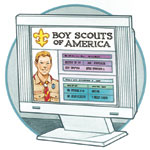
News Briefs
President honors Little Sioux Scouts
Surviving an EF 3 tornado is a tough way to get an audience with the President of the United States. But a group of Boy Scouts and Scout leaders from the Mid-America Council made the best of their opportunity.
The 115 boys and 10 adult leaders from Nebraska and Iowa were present at Iowa’s Little Sioux Scout Ranch when a twister tore through the campsite and killed four of their peers on June 11.
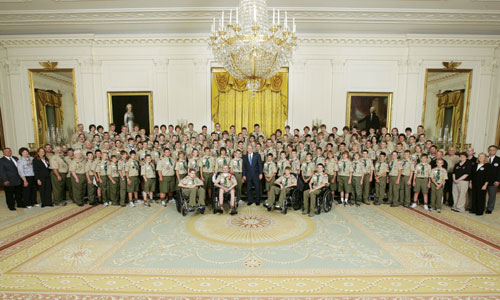 President George W. Bush honors survivors of the deadly tornado that hit Iowa’s Little Sioux Scout Ranch in June. In all, 115 boys from the Mid-America Council met the president in the East Room of the White House on July 31. |
Accompanied by family members, leaders, Scout Executive Lloyd Roitstein, and other council professionals, the boys journeyed from Omaha, Neb., to Washington, D.C., on July 31. Arriving that morning in the nation’s capital, the Scouts were given a police escort to the White House and taken to the East Room.
There, President George W. Bush praised the courageous assistance they gave their 48 fellow Scouts who suffered serious injuries in the storm -- four were still in wheelchairs during the White House visit.
Hundreds of downed trees hindered rescue efforts. But one emergency medical technician on the scene reported that the youngsters had begun helping one another even before emergency crews arrived.
“These young men left even the most experienced of the paramedics awestruck, amazed by how they used their Scout skills and triaged the situation well before the responders arrived,” said Chief Scout Executive Robert Mazzuca, after learning of the disaster and visiting the site.
“It is a case study in how to do things right in a terrible situation like this. Our Scouts have left a lot of lessons for others to learn.”
Although some of the Scouts felt a bit ambivalent about the occasion, Sam Wendt of Troop 812 summed up the group’s feelings to Omaha’s KETV: “Everyone needs to know that we’re grateful here,” Wendt said, “but we wish that we could be seeing the president for different reasons other than losing friends.”
Later in the day, three of the boys and their junior leader training course director met with journalists at the National Press Club and then met the rest of the group at the Capitol, where congressional delegations from Nebraska, Iowa, and South Dakota honored their courage and their actions.
On a weekend in early August, the Boy Scouts, leaders, and families returned to Little Sioux Scout Ranch to memorialize those who were killed and begin the process of rebuilding the campsite.
“I [was] deeply saddened by these terrible losses,” Mazzuca has said. “At the same time, I am very proud of the way our Scouts and leaders responded. Even in the face of incredible challenge, they epitomized the very best about being a Scout.”
Getting to the 2010 Jamboree
Do you know what it takes to get your Scouts signed up for the 2010 National Scout Jamboree?
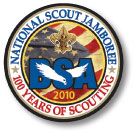 By now, you surely know the BSA’s 100th birthday bash will take place July 26 to Aug. 4 at Fort A.P. Hill in Caroline County, Va., near Fredericksburg and Washington, D.C.
By now, you surely know the BSA’s 100th birthday bash will take place July 26 to Aug. 4 at Fort A.P. Hill in Caroline County, Va., near Fredericksburg and Washington, D.C.
You also know that about 43,000 boys and adult leaders will attend. Scouts will participate in plenty of exciting outdoor activities that include confidence courses, bikathalons, buckskin games, as well as hone their Scout skills, tune up their physical fitness, and learn lessons in environmental conservation and our nation’s heritage.
According to John Alline, BSA’s national jamboree director, participants will be selected by the more than 300 Scout councils across the country. Still, a quick study now of the qualifications will give them, and you, a leg up on the application process.
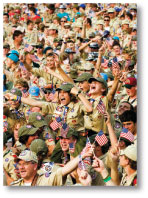 Scouts must have:
Scouts must have:
- received approval from their Scoutmaster or Varsity Scout Coach and the local council jamboree committee.
- attained the rank of First Class Scout.
- completed the sixth grade, or at least reached the age of 12 by July 1, 2010.
- attended a pre-jamboree training experience.
- demonstrated troop activity for at least six months prior to July 1, 2010.
Additionally, Scouts cannot have reached their 18th birthday by Aug. 3, 2010, to be eligible.
For more information on qualifications for Boy Scouts or unit leaders, or to register, visit www.bsajamboree.org.
Start now to give your Scouts their best shot at joining the festivities.
SCHOLARSHIPS FOR EAGLES
Eagle Scouts who will graduate from high school in spring 2009 and plan to attend an accredited college or university that awards a bachelor’s degree can apply now for a National Eagle Scout Association (NESA) scholarship.
In addition to their Eagle Scout rank, the candidates must have acceptable SAT and/or ACT scores, as judged by the review committee, and demonstrate leadership in Scouting and strong participation in activities outside of Scouting.
NESA awards a varying number of national $3,000 scholarships each year from its general fund, in addition to the Mabel and Lawrence S. Cooke Scholarships.
These include four $20,000 awards (payable at $5,000 per year) and one $48,000 scholarship (up to $12,000 for four years).
In addition, the Hall/Mc-Elwain Merit Scholarship pays a varying number of Eagle Scouts $1,000 awards.
As merit-based awards, these are available to students from their senior year in high school through their junior year in college.
Expect fierce competition. NESA receives more than 5,000 scholarship applications each year. It awards fewer than 100. Scholarship committees form each year in the BSA’s four regions: Northeast, Southern, Central, and Western. The NESA Scholarship Committee makes all final determinations.
Eagle Scouts can find an online application at www.nesa.org after Nov. 1, or they can pick up one at their local Scout council service center, or from NESA, 1325 W. Walnut Hill Ln., Irving, TX 75038.
Make sure the application arrives no later than Jan. 31, 2009.
Don Murphy, 1918-2008
Don Murphy, founder of the pinewood derby, died July 1, 2008, in Torrance, Calif.
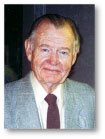 As Cubmaster of Pack 280C in Manhattan Beach, Calif., in 1953, Murphy was seeking a project for his son, who wasn’t old enough to participate in the Soap Box Derby. Murphy had built model airplanes, cars, and boats when he was a kid in La Porte, Ind., and hit upon the idea to create a miniature version of the Soap Box race.
As Cubmaster of Pack 280C in Manhattan Beach, Calif., in 1953, Murphy was seeking a project for his son, who wasn’t old enough to participate in the Soap Box Derby. Murphy had built model airplanes, cars, and boats when he was a kid in La Porte, Ind., and hit upon the idea to create a miniature version of the Soap Box race.
Murphy designed a small car carved out of soft pinewood, created the rules, and named the event. The Management Club at North American Aviation, where he worked, sponsored the first derby, paying for wood and other materials.
“Originally, the block of wood we included in the kit was carved down in the forward third to a kind of cockpit,” Murphy told Scouting magazine in a 1999 interview. “We put the wood, wheels, and nails into a brown paper sack with an assigned number.”
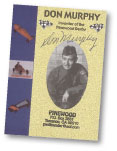 Cub Scout dads built the original ramp — 31 feet long — with a battery-operated signal at the finish line made from doorbells and flashing light bulbs to identify the winner.
Cub Scout dads built the original ramp — 31 feet long — with a battery-operated signal at the finish line made from doorbells and flashing light bulbs to identify the winner.
The concept caught on. Within a year of its debut, the pinewood derby had been adopted for use in all Cub Scout packs. Estimates suggest that more than 100 million Cub Scouts have participated in the event over the past 55 years.
Murphy recalled that he wanted “to devise a wholesome, constructive activity that would foster a closer father-son relationship and promote craftsmanship and good sportsmanship through competition.”
Mission accomplished.
Say hey, globally
Radio-ready and Web-wise Cub Scouts, Boy Scouts, and Venturers take note: The 51st annual Jamboree-on-the-Air (JOTA) and 12th Jamboree-on-the-Internet (JOTI) takes place Oct. 18-19.
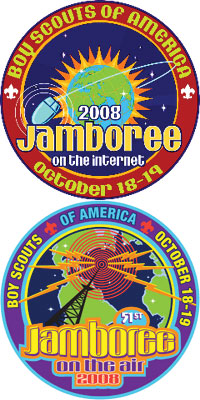 Sponsored by the World Organization of the Scout Movement, the two events allow youths to make contact with Scouts and Guides from all around the world via short-wave radio and personal computers.
Sponsored by the World Organization of the Scout Movement, the two events allow youths to make contact with Scouts and Guides from all around the world via short-wave radio and personal computers.
Cub Scouts, Boy Scouts, and Venturers can make contact with other youngsters in more than 150 countries. BSA officials expect about a half-million Scouts and Scouters to participate.
For JOTA, young amateur radio enthusiasts get to experience the excitement of exchanging Scouting adventures and other ideas in conversations with their peers. Dens and patrols must visit local, licensed ham radio operators to help extend their greetings, while many local councils and districts will set up special stations to transmit the signals.
Similarly, many councils and districts sponsor events and provide computers for JOTI, in which Scouts can work with leaders to send e-mails, visit Scout chat rooms, and exchange audio and video presentations. Register for JOTI at www.joti.org, and then check out www.scoutlink.net for a safe, supervised chat site.
You can take part in both JOTA and JOTI for 48 hours — all day Saturday and Sunday.
Find more information on participation — language translation service, making appointments for contacts beforehand, certificates, and patches — at www.scouting.org/international/highlights. After you’ve experienced one or both events, you’ll find a printer-friendly version available on the Web site of a report you can complete and e-mail to intnldiv@netbsa.org along with your photos. Your comments will be forwarded to the European Region for inclusion in its annual report.
The great (tasting) outdoors
If it were a movie, the commercial’s voiceover would bellow, “Ripped from the pages of Scouting magazine!”
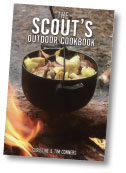 But it’s not a movie. It’s a book: The Scout’s Outdoor Cookbook (Globe Pequot Press, 2008).
But it’s not a movie. It’s a book: The Scout’s Outdoor Cookbook (Globe Pequot Press, 2008).
Still, the wife-and-husband writing team of Christine and Tim Conners of Statesboro, Ga., did rip their recipes from the pages of Scouting.
In the book’s acknowledgments, the authors dish out credit for kick-starting the project to us for providing hundreds of recipes that were entered in the magazine’s popular camp-cooking contest.
“Through this treasure trove of data,” write the Conners, “we were able to make contact with dozens of experienced camp cooks.
Their recipes and advice became an invaluable foundation and springboard.”
Recognizing the undeniable importance of camp cuisine to the BSA, the Conners compared notes with almost 200 outdoor chefs from across the United States.
Organized into sections titled Breakfast, Lunch, Dinner, Breads, and Snacks and Desserts, the trade-size paperback features more than 340 recipes for cook pots, skillets, tin foil, Dutch ovens, grills, and more.
Wash down all that fresh-air fare with items from the Drinks section, which offers liquid concoctions with comical names such as “It’s Orangealicious!” (it is), “Lousy Lemonade” (it isn’t), and “Fire Starter Cider” (it won’t, we presume).
Bonus how-to’s include tips for getting started in outdoor cooking, simple instructions for low-impact cooking, buying advice for equipment and tools, and even a handy guide for cooking in a cardboard box—with duct tape.
BSA Supply No. 34537, $19.95
Color Merits Attention
Look for a striking change in the design of the BSA’s merit badge pamphlets.
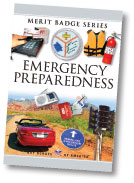 Instead of the long-standing black-and-white design, you’ll find them all in full color with snazzy photos that draw young readers to each adventurous topic.
Instead of the long-standing black-and-white design, you’ll find them all in full color with snazzy photos that draw young readers to each adventurous topic.
Check out the hot-red convertible on the cover of Emergency Preparedness, the vibrant yellow tractor on Farm Mechanics, and the cool, blue water on Swimming. All three titles will see major revisions.
Other titles with updated information for 2008 include Auto Mechanics, Engineering, Lifesaving, Motor Boating, and Radio.
And with the debut of the new look, the series shrinks to 119 titles because of the merger of Architecture and Landscape Architecture into one pamphlet.
Pick up your new merit badge pamphlets, which will sell for $4.49 each, at the local Scout Shop nearest you, or place an order on www.scoutstuff.org.
Fuel for Thought During Fire Prevention Week
Successful camp-outs demand appetizing hot meals and adequate lighting. That’s why Scouters take stoves and lanterns into the great outdoors.
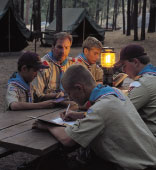 But according to Richard Bourlon, leader of the BSA’s Health and Safety team, knowledgeable adult supervision remains a must when you’re storing or handling chemical fuels, especially when filling stoves and lanterns.
But according to Richard Bourlon, leader of the BSA’s Health and Safety team, knowledgeable adult supervision remains a must when you’re storing or handling chemical fuels, especially when filling stoves and lanterns.
In conjunction with Fire Prevention Week (Oct. 5-11), Bourlon reminds campers that the BSA maintains detailed guidelines for fuel safety and fire prevention, and he offers this refresher course on some of the major dos and don’ts:
- Use compressed- or liquid-gas stoves or lanterns in Scout facilities only where and when permitted.
- Operate and maintain them according to manufacturer’s instructions.
- Keep gasoline and kerosene in well-marked, approved containers (never glass) and store in a ventilated, locked box at a minimum of 20 feet from buildings and tents.
- Let hot stoves and lanterns cool before changing or refilling cylinders.
- Refill liquid-gas stoves at a safe distance from any flames.
- Always fuel a stove, heater, or lantern outdoors.
- Do not operate a stove, lantern, or charcoal grill in an unventilated structure.
- Never fuel, ignite, or operate a stove, heater, or lantern inside a tent.
- Place stoves on a level, secure surface.
- When lighting a stove, keep fuel containers and extra canisters a safe distance away.
- Do not leave a lighted stove or lantern unattended.
- Do not overload the stovetop with heavy pots or large frying pans.
- Bring empty fuel containers home for disposal.
“Remember that you’re prohibited from using flammable or combustible liquids such as gasoline, diesel fuel, alcohols (rubbing or denatured), naphtha, lighter fluids, or oils to start any type of fire,” Bourlon says. He recommends solid-type starters that are “just as effective, easier to store and carry, and safer.”
So before your next camp-out, get smart about all of the BSA’s Fuels and Fire Prevention guidelines at www.scouting.org/healthandsafety in the “Guide to Safe Scouting.” Check additional info on the National Fire Protection Association Web site at www.firepreventionweek.org.
How to foil trailer theft
Imagine preparing to attend the fall district camporee with your Scouts and discovering that the troop’s trailer and all the camping equipment stored inside were missing. Besides ruining your trip, trailers and equipment are expensive to replace.
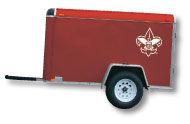 Phillip Moore, assistant director of the BSA’s Insurance and Risk Management Service, says a recent upsurge in stolen trailers and camping equipment is being reported across the United States. Since many chartered organizations such as churches and civic groups do not have the space to secure trailers and store equipment, which often is kept onsite in the trailers, they make an attractive target for thieves.
Phillip Moore, assistant director of the BSA’s Insurance and Risk Management Service, says a recent upsurge in stolen trailers and camping equipment is being reported across the United States. Since many chartered organizations such as churches and civic groups do not have the space to secure trailers and store equipment, which often is kept onsite in the trailers, they make an attractive target for thieves.
So if you don’t want to shell out thousands for new stuff, take the advice of the BSA’s Insurance and Risk Management Service, which recommends two easy steps to lock down your trailer and thwart thieves.
First, purchase a wheel lock similar to boots used by police officers on illegally parked cars. Find one by checking out a local boat dealership.
“The wheel lock is a visible deterrent and does not allow the trailer to be moved,” Moore says.
Second, always park your trailer so that its rear doors butt up against a wall or some other permanent structure. Situate it against parking blocks or a curb so that it cannot be turned or moved.
“Many trailers have locks that can be used on the trailer hitch,” he says. “But if a trailer hitch lock is the only deterrent used, thieves can still maneuver the trailer around. And once the trailer is moved, thieves can cut the lock and steal the contents.”
Of course, if the thieves want the trailer badly enough, Moore says, they still might get it. But a little extra effort, and very little expense, on your part can convince them it’s not worth the hassle.